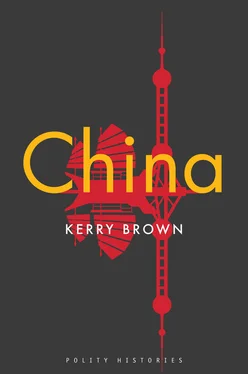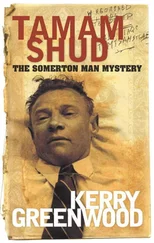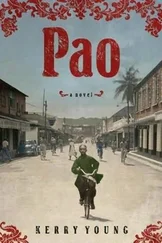The introduction of a planned economy had two main characteristics. The first was to mark a shift away from the business model of small entrepreneurial companies that had existed prior to the 1950s. China had been a country of artisan business people, largely working in small family-owned enterprises. Larger corporations and industrial companies that had characterized Western capitalism had never existed. ‘The organization of large shareholders’ companies, on which the development of Western capitalism was founded,’ historian Marie-Claire Bergère wrote, ‘implied a distinctive hierarchy and gave shareholders the right to supervise the company’s management. In contrast, traditional Chinese capitalism depended upon networks of personal relations and family and geographical systems of solidarity, favouring forms of lateral communication rather than vertical hierarchies.’ 9Under Communism, the desire was for industrialization, steep increases in material living standards, and a shift away from agriculture towards manufacturing and mechanization. Mao himself referred to state capitalism, a new kind of economic model in China, when he wrote in 1953 that ‘the present-day capitalist economy in China is a capitalist economy which for the most part is under the control of the People’s Government.’ 10
The second feature was the emphasis on class struggle and the need to transform society more radically, innovations taken by Mao from Marxist-Leninist theory. In ‘Correct Handling of Contradictions Among the People’, Mao declared that the Chinese bourgeoisie, since the conversion of privately owned industrial and commercial entities in the previous year, were ‘being transformed from exploiters into working people living by their own labour’. As long as they still got revenue from their enterprises, they had ‘not yet cut themselves loose from the roots of exploitation’. 11After Mao’s death, the original words unpolished by his editors were finally issued. They were even more categorical: ‘During past decades have the capitalists been so wise that they don’t have to remould even a little? I don’t think so. Even I need to remould [myself].’ 12The ensuing Great Leap Forward from 1958, aimed at accelerating the country’s development and increasing the collectivization of industry and agriculture, was the tool by which to achieve this grand transformation.
Many of China’s key industrial conglomerates, some of which exist in some form to this day, were founded in the 1950s during the first Five-Year Plan period. The ‘ Danwei ’ (work unit) system was set up around many of these, supplying education, kindergartens, healthcare, accommodation, work, and provision for the elderly. One of the striking features of the CPC’s development over this time was the ways by which, through economic, educational, and other means, it was able to move into almost all levels of society, and all areas of life, largely enjoying a monopoly. It achieved this remarkably quickly, becoming by the end of the 1950s the sole, nationwide, uncontested source of organization and political expression. ‘Society has been politicized to an unprecedented degree,’ Political scientist A. Doak Barnett observed a decade later. These changes had led to ‘a great expansion of the organizational apparatus of political power at all levels. … The regime has had to build new institutions to enable the nation’s leaders not only to police the entire society, but also to manage the economy as a whole and indoctrinate the mass of the population.’ 13
Land Reform: China’s Earliest Harvest of Sorrows
One of the paradoxes of Maoist politics was that despite its opposition to urban-based capitalism, and its core support coming from rural China (the urban population being then so small), the countryside was to suffer the greatest calamities. The famines in the 1960s are the most extreme example of this, with rural areas largely starved in order to feed cities. Land Reform was one of the most important political movements sponsored by the Mao government from 1949 onwards and it directly impacted on the countryside. Mao had earlier observed abuse against exploitative landlords in his native Hunan in the 1920s, writing a famous report on this. 14This was to frame his world-view in subsequent decades. China’s countryside was the home to most people, but it was a place of pre-modernity, the epitome of the old society and the exploitation it involved.
Since ancient times, land had been a source of power and wealth. Those with land at least had security. But some had accrued large amounts, and others ended up with nothing, being no better than indentured slaves. If China was to reform, then the countryside needed to undergo revolution – and that meant addressing the inequalities of land ownership. State control needed to be introduced. As the 1950 Agrarian Reform Law stated in its preamble, the current arrangement was one of feudal exploitation by the landlord class ‘and should be abolished and the system of peasant land ownership shall be introduced in order to set free the rural productive forces, develop agricultural production, and thus pave the way for China’s new industrialization’. 15
Of all the components of the Land Reform movement, before and after it was rolled out nationally, ‘struggle sessions’ were the most infamous. Mao had witnessed these in Hunan in 1926, theatrical events in which those under investigation were marched around the streets humiliatingly wearing tall dunce’s hats emblazoned with their name. Eye-witness American farmer William Hinton observed the ethos of struggle sessions enacted against Party members through the eyes of a cadre called Hou:
In work review meetings during the past week Comrade Hou had stressed the need to keep the movement from developing into a ‘struggle’ against the Party and cadres as individuals. The work time must keep in mind the real virtue of those whose records were under review. It must sustain their morale, preserve their sanity and keep alive in them that spark of courage, energy and ability which had made them leaders in the past. 16
A similar need for judiciousness was necessary when landowners were exposed and had to submit to discipline and public correction. Hinton does refer obliquely to violence in his account. But other testimony shows that violence was not an unfortunate, occasional outcome of this movement, but a core part of it. Mao had been the proponent of revolution being a necessarily violent event. It was not, as he famously declared, a dinner party. Violence was inevitable and ubiquitous. The Land Reform movement was to see as many as 2 million perish, with countless other acts of physical violence against those targeted. ‘Under the new guidelines of “not correcting excesses prematurely” the aroused masses frequently engaged in unchecked outbreaks of violence and brutality.’ 17It was the first widescale campaign which created a new class in the PRC – disgruntled victims – and a new elite – the middle peasants who had benefited from the redistribution. China’s renewal and regeneration, as shown by this example from the very dawn of the PRC, was to be a process in which there were always clear winners and losers, and in which compromise and consensus were never easy, nor, perhaps, even the objective.
As early as 1957, American psychologist Robert J. Lifton was able to record the ‘ sixiang gaizao ’ (thought reform) for which increasing evidence was emerging within the PRC. The aim was therefore clearly to remake not just the physical world of the Chinese people, but the inner one too. This showed the radical difference between the Communists and the Nationalists they had defeated. They had a new vision of what a Chinese person should be, and of the techniques that needed to be used in order to achieve this. According to Lifton, this consisted of confessions, in which individuals in writing or in public recounted the deeds they had done in the old world, before the regime came into existence, and the sins they had committed. With this act completed, they were able to move on to a programme of re-education. 18
Читать дальше












